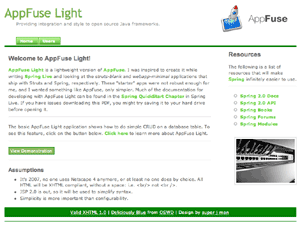AppFuse Light 1.8 Released
AppFuse Light 1.8 adds CSS Framework integration, as well as support for Stripes (1.4.2) and Wicket (1.2.6). It also has significant upgrades for JSF and Tapestry; to versions 1.2 and 4.1.3 respectively. See the Release Notes for more information on what's changed since the the beta release of 1.8.
What is AppFuse Light? Click here to find out.
AppFuse Light now offers 60 possible combinations for download:
- Web Frameworks: JSF (MyFaces), Spring MVC (with Ajax, Acegi Security, JSP, FreeMarker or Velocity), Stripes, Struts 1.x, Struts 2.x, Tapestry, WebWork, Wicket
- Persistence Frameworks: Hibernate, iBATIS, JDO (JPOX), OJB, Spring JDBC
If you have any questions about this release, please subscribe to the AppFuse user mailing list by sending a blank e-mail to [email protected]. You can also post questions in a forum-like fashion using Nabble: http://appfuse.org/forum/user.
If you're a developer of one of the frameworks that AppFuse Light uses - I'd love a code review to make sure I'm "up to snuff" on how to use your framework. I'm also more than willing to give commit rights if you'd like to improve the implementation of your framework.
Live demos are available at:
- Spring · Spring + Ajax · Spring + Acegi
- MyFaces + Facelets
- Stripes
- Struts 1 · Struts 2
- Tapestry
- WebWork
- Wicket
Yes, I realize that 60 combinations is ridiculous. I didn't create the frameworks, I'm just integrating them so you don't have to. 
Unfortunately, it's a real pain to create Maven archetypes or they'd all be as easy as mvn archetype:create. Rumor is that the archetype plugin will allow you to create-from-project in the future. When that happens, I'll make sure all the combinations are available as archetypes.


